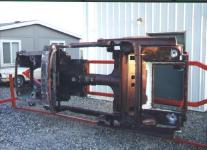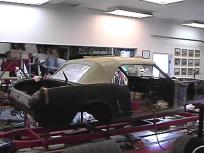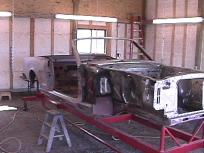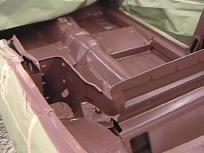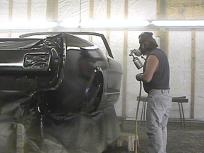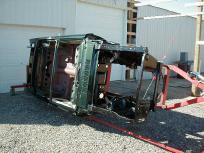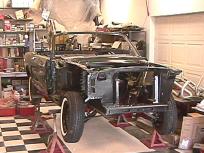|
In many of the images you will see the unibody of the car attached to our own unique design full frame rotisserie. Unlike most commercial rotisseries, Horse Heaven's is specifically designed to attach to the unibody of a Mustang at the same points the buck was originally attached to the assembly line fixture. The result is that the unibody's dimensions are maintained precisely throughout the process, and even the paint shadows left at the attaching points are identical to those left by the original process. In this photo, all of the main structural elements of the unibody have been removed, along with most of the exterior sheet metal and floor pans.
|
As each part of the car is disassembled, any original markings are recorded photographically and/or in writing. These hundreds of images and pages of documentation are used during re-assembly to be sure each detail is duplicated. Samples of original materials are archived to be sure that each reproduction is as close as possible to the original. Here we photographed the runny paint "blobs" used to coat the welds where the axle tubes were attached to the carrier housing.
|
The convertible top and other trim parts are fitted prior to painting to avoid any distress to the painted body later.
|
The reconstructed unibody begins the paint process, still attached to the rotisserie. By this point, any rusty or damaged sheet metal has been repaired or replaced, and the entire body has been assembled and each panel carefully fitted to assure proper seam allowances. All structural elements including the rocker panel assemblies, torque boxes, and cross members have been rewelded using processes that are strong and that duplicate the appearance of the factory resistance welds, brazes, and wire-feed welds where each was evident. Unlike the original production, each boxed structure is epoxy primed inside before being closed, minimizing the opportunity for corrosion in the future.
|
|
All body surfaces not painted body color are epoxy primed using a custom-mixed shade identical to the original factory primer. Painted surfaces use substrates similar to the final coat to minimize the evidence of eventual stone chips and scratches. All paint materials are documented and several quarts of the body color are retained in the event that spot or panel repairs are ever needed.
|
The highest quality PPG materials are applied in our paint facility by experienced professional painters with almost 30 years of combined experience doing complete auto paint work. Body and paint time alone on this restoration exceeded 250 hours.
|
On September 11, 2001, the unibody is finally readied for removal from the full frame rotisserie, now that all of the paint and polishing is complete.
|
After removal from the rotisserie, the first components attached are the suspension and wheels. Even the wheels are three of the same five that originally came with the car, and two others were located with identical date codes. Door handles and latches are installed, and the rest of the final assembly commences in nearly identical order to the assembly line in San Jose, 36 years earlier.
|

